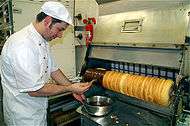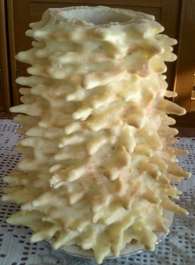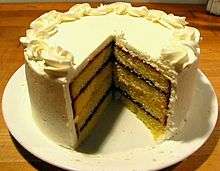Baumkuchen
Baumkuchen is a German variety of spit cake. It is a traditional pastry of many European countries, and also a popular snack and dessert in Japan. The characteristic rings, which resemble tree rings when sliced, give the cake its German name, Baumkuchen, which literally translates to "tree cake".[1][2]
| Type | Layer cake |
|---|---|
| Place of origin | Germany |
| Main ingredients | Flour, butter, eggs, sugar, vanilla |
| Variations | Schichttorte, Trdelnik, Gâteau à la broche, Spettekaka |
History
The origins of baumkuchen are a matter of controversy. The State of Bavaria claims that baumkuchen has been created since at least the 19th century in Bavaria.[3] Another line of thought suggests that this cake had its beginnings as a Hungarian wedding cake, that is, a derivative of the oldest Hungarian pastry kürtőskalács (chimney cake). A recipe for baumkuchen appears in Ein new Kochbuch (literally "A New Cookbook"), published in 1581, the first cookbook written for professional chefs by Marx Rumpolt.[4] Marx Rumpolt had previously worked as a chef in Hungary and Bohemia. In 1682, a rural medic working for Johann Sigismund Elsholtz prepared a similar dessert.
Aside from the above mentioned recent history, baumkuchen was already known in Ancient Greece and the latter Rome. The Roman conquerors brought the method for baking cakes on logs over an open fire to what is today Germany and its surroundings.[2][5]
Characteristics

This labor-intensive, and thus rather expensive, specialty is made on a spit by evenly brushing on thin layers of batter, then rotating the spit over a heat source, traditionally a wood fire. Each layer is allowed to dry before another layer of batter is poured over the previous.[6] When the cake is removed and sliced, each layer is divided from the next by a golden line, resembling the growth rings on a crosscut tree. A typical baumkuchen is made up of 15 to 20 layers of batter.[5] Baumkuchen can be large: skilled pastry chefs have been known to create cakes with 25 layers and weighing over 100 pounds.[6] When cooked on a spit, it is not uncommon for a finished baumkuchen to be 3 to 4 feet tall.[3]
Baumkuchen ingredients are typically butter, eggs, sugar, vanilla, salt, and flour. Baking powder is not considered a traditional ingredient. The ratio of flour, butter and eggs is typically 1:1:2 respectively (i.e., 100 grams of flour, 100 grams of butter, and 200 grams of eggs). The recipe can be varied by adding other ingredients, such as ground nuts, honey, marzipan, nougat and rum or brandy, to the batter or filling.[2] Additionally, baumkuchen may be covered with sugar or chocolate glaze. With some recipes, the fully baked and cooled baumkuchen is first coated with marmalade or jam, and then covered with chocolate.
Baumkuchenspitzen
Baumkuchenspitzen, German for "tree cake tips", are miniature versions of baumkuchen that are created from the cake when it is cut in slices and then into pieces that are referred to as "Spitzen". These pieces are typically coated in chocolate and sold individually.
Schichttorte
A simpler horizontally layered version of the cake is called a "Schichttorte". It is baked without a spit, which results in horizontal layers instead of circular rings. The Schichttorte is more like a conventional cake in shape and can be baked in a conventional home oven that has a broiler inside, whereas the traditional spit version requires special equipment normally not available in an average home. Compared to the spit variant, the Schichttorte's cross section is less reminiscent of tree rings.
In Japan
Baumkuchen is one of the most popular pastries in Japan, where it is called bāmukūhen (バームクーヘン). It is a popular return present in Japan for wedding guests because of its typical ring shape.[7]
It was first introduced to Japan by the German Karl Joseph Wilhelm Juchheim. Juchheim was in the Chinese city of Tsingtao during World War I when Britain and Japan laid siege to Tsingtao. He and his wife were then interned at Okinawa.[8] Juchheim started making and selling the traditional confection at a German exhibition in Hiroshima in 1919. After the war, he chose to remain in Japan. Continued success allowed him to move to Yokohama and open a bakery, but its destruction in the 1923 Great Kantō earthquake caused him to move his operations to Kobe, where he stayed until his death just before the end of World War II. Some years later, his wife returned to help a Japanese company open a chain of bakeries under the Juchheim name that further helped spread baumkuchen's popularity in Japan.
Other regional variations

- Austria – Baumkuchen are known as Prügelkrapfen
- Czech Republic – Popular under the name Trdelnik
- France – Gâteau à la broche
- Luxembourg – Baamkuch has become a traditional dish served mostly on special occasions, such as weddings, christenings, etc. Yet, the cake is available all year around in certain supermarkets.
- Poland – Known as Sękacz
- Lithuania – Šakotis or Raguolis (Bankuchenas as known in western Lithuania, itself word is loanword from German Baumkuchen) is a similar cake also cooked on a spit, normally over an open fire
- Sweden – Spettekaka with the protected geographical indication (PGI) registered by the EU
- Hungary and Romania – Kürtőskalács is a similar cake also cooked on a spit
- Slovakia – Skalický trdelník with the protected geographical indication (PGI) registered by the EU
- Turkey – Makara tatlısı is a similar cake also cooked on a spit.
- Indonesia – Spekkoek (kue lapis legit or spekuk) was developed during colonial times in the Dutch East Indies. The firm-textured cake is an Indo (Dutch-Indonesian) version of the European multi-layered spit cake.
Gallery
 Baumkuchen with white icing before slicing...
Baumkuchen with white icing before slicing... and after.
and after. Baumkuchen with couverture chocolate
Baumkuchen with couverture chocolate- Baumkuchenspitzen, German for "tree cake tips"

See also
- List of desserts
- List of spit-roasted foods
- Streuselkuchen
- Spekkoek, a Dutch-Indonesian related recipe that doesn't include the sweet shell.
References
| Wikimedia Commons has media related to Baumkuchen. |
- Sheraton, Mimi (23 November 2009). "Spit Cake". The New Yorker. Retrieved 9 February 2015.
- Stanley Cauvain and Linda Young (2001). Baking problems solved. Woodhead Pub Ltd, p. 261. ISBN 0849312213.
- Mimi Sheraton (November 23, 2009) How to bake spit cake. The New Yorker. Retrieved on 2013-02-04.
- Alan Davidson and Tom Jaine (2006). The Oxford companion to food. Oxford University Press, USA, 2006. p. 805 ISBN 0192806815.
- Baumkuchen (Pyramid cake). corsoela.de
- Baumkuchen – the King of Cakes!. Germanculture.com.ua (2007-11-28). Retrieved on 2013-02-04.
- Anja Hankel (November 2009). "Loanwords in Japanese" (PDF). Awa Life. TOPIA. 232: 6. Archived from the original (PDF) on 2011-07-22.
- Origins of baumkuchen, cheap onsen trips and this week’s CM: Final Fantasy XIII | The Japan Times Online. Search.japantimes.co.jp (January 10, 2010). Retrieved on 2013-02-04.
